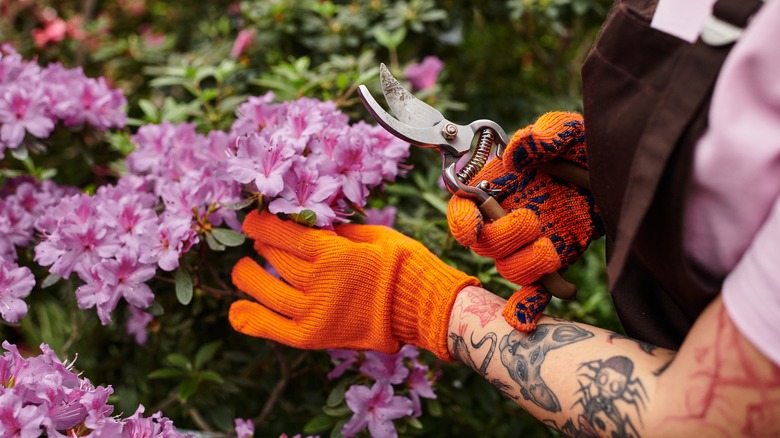Why It's A Good Idea To Avoid Pruning Azaleas In The Fall (And What Time Of Year You Should Be Doing It Instead)
Let's be honest — if an azalea isn't in full bloom, it's not the most distinct shrub. Its foliage is typically solid green, though you'll find a few out there with white or yellow variegation. The real stars of the show are the brilliant blooms, which come in a variety of colors and patterns. But once they pass, the shrub tends to fade into the background. For this reason, caring for and pruning azaleas to ensure a robust production of flowers is a must if you want your plant to stand out in your garden.
Fall may feel like the right time to prune an azalea, especially while you're out raking leaves and tidying up summer planters. However, don't get out your pruning shears just yet. The prime time to prune a spring-blooming azalea is immediately after it flowers, but before new buds appear. Pruning it in the fall, or anytime after its buds grow, cuts off next year's blooms. An earlier pruning also allows the plant plenty of time to heal, making it less susceptible to frost damage.
The timing of an azalea's blooms will depend on its variety and the local weather. Gardeners can see flowers as early as March and as late as September. In general, areas with warmer spring weather will see earlier flowers while regions with cooler springs enjoy azalea blooms later. Also, some varieties may have extended bloom times in warmer climates and a more condensed window in colder areas. Some may even reward gardeners in particularly warm areas, like in the South, with a second round of flowers in the fall.
Tips for pruning azaleas
If you're simply pruning dead or damaged branches, this can be done any time of year. But if you're pruning for shape or size, this is when timing matters. How you prune may depend on the variety of your azalea, namely whether it's evergreen (Rhododendron tsutsusi) or deciduous (Rhododendron pentanthera). Evergreen azaleas are typically pruned for shape, such as dense mounds or hedges. As tempting as it may be, don't just shear the surface of the azalea, which could result in half-cut leaves and branches cut in the wrong places. Pruning more discriminately — branch by branch — will result in a more attractive shrub, with the new growth and flowers along the surface. Also, it's important to prune some inner branches to allow for air circulation and light for a healthy plant.
Deciduous azaleas are pruned for control and for shape, though less densely or structured than evergreens. Whether cutting back evergreens or deciduous varieties, make the cuts slightly above where two branches intersect or right above a circular cluster of leaves. If your plant has become leggy or scraggly, get a fresh start by cutting it nearly down to the ground, leaving about 8 to 10 inches. However, expect to wait a few years before the azalea looks full again or even before it flowers. If this doesn't appeal to you, start with cutting back a few branches at a time. As always, start with sterilized pruning shears, and be sure to clean them afterward to avoid transmitting diseases among plants.

